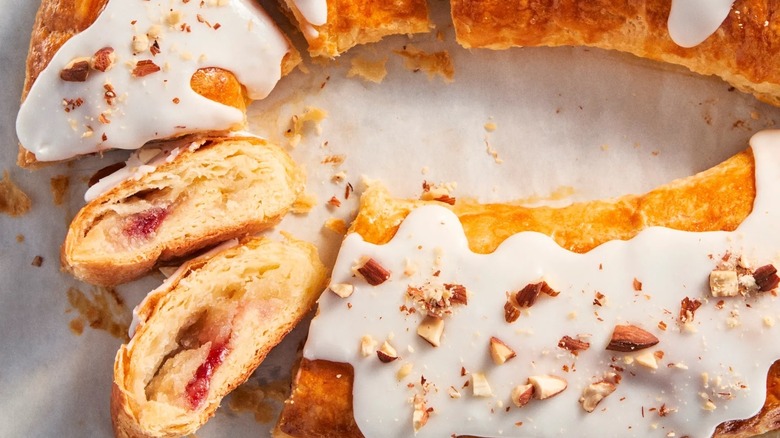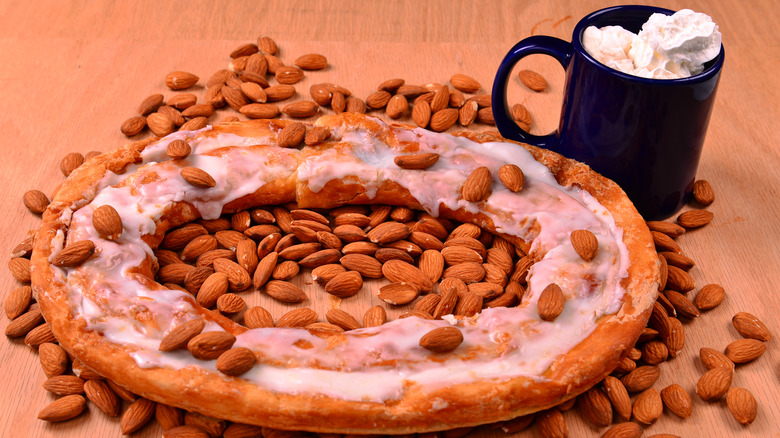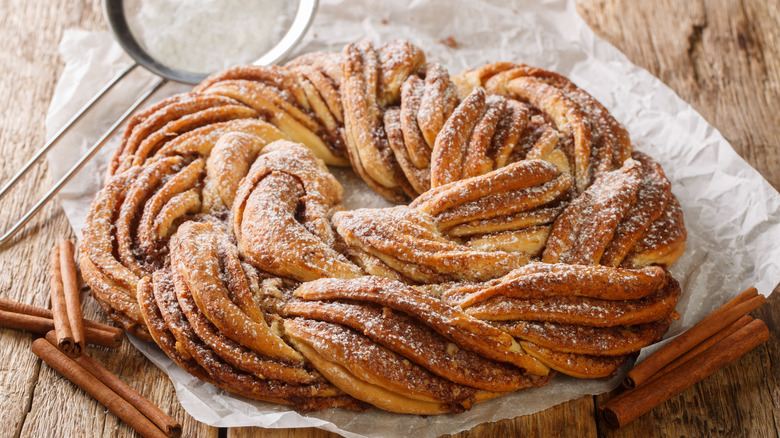Wisconsin's State Pastry Is A Sweet Danish Classic
Every state embraces the things that make it unique, from state songs, flags, mottos, and nicknames to things that are a little more fun. There are state dogs, birds, beverages, and even state dirt. Really. For Wisconsin, that's Antigo silt loam, a soil that's key to its corn and grain production. Fortunately for Wisconsinites, that ultimately lead to the creation of their state pastry, the kringle.
It wasn't until 2013 that the kringle was officially made state pastry, but it's been around for a lot longer than that. In fact, kringles were established as a favorite not long after Wisconsin's official establishment as a state, which happened in 1848. Kringles were brought to Wisconsin by Danish immigrants who settled in the area and continued making their time-honored, long-beloved pastries. Today, several family-owned bakeries continue the tradition.
It makes sense, then, that there are many different versions of the kringle. These circular, buttery, flaky pastries take several days to make and might vary slightly in shape and flavor. Today, bakeries are whipping up a ton of them, stocking everything from the holiday-inspired cranberry kringle to kringles covered with frosting or made with fruits, nuts, and other toppings.
What, exactly, is a kringle and how is it made?
There's no one tried-and-true way to make a kringle, but some elements to the process are pretty standard. Traditional kringles — whether they're round or horseshoe-shaped – start with a pastry dough that's mixed, rolled, and then refrigerated. Although recipes for easy Danish kringles might look simple, kringles made the old-school way involve a multi-day process. On the second day, the dough is rolled and refrigerated again before being rolled for a final time and baked on the third day. It's the dough that's crucial to the kringle experience. It's thin, flaky, and buttery, and the number of dough layers varies but is typically somewhere around 30.
Today, several bakeries in Wisconsin still making these traditional pastries, and to say they're wildly popular is an understatement. Eric Olesen is the third generation owner of O&H Danish Bakery in Racine, Wisconsin, and told the Milwaukee Journal Sentinel that they send kringles all over the world — even shipping them to Antarctica. He also estimates that their physical locations sell somewhere between 10,000 and 15,000 kringles per week, and they're just one of several Danish bakeries in the state. Around the holidays, another bakery, Racine Danish Kringle, says that number jumps to around 12,000 sold daily.
The kringle has a long and fascinating European history
The kringle has been around for much longer than America, and it goes back to a point in history where things get a little fuzzy. The idea first gained popularity in the 13th century, and it's believed that the process of layering butter and dough and then rolling out thin layers wasn't initially Danish at all – it was Austrian. The original kringle was shaped like a pretzel, and the change to today's oval shape was made to accommodate more filling within the layers. Still, the traditional pretzel shape can still be seen across Denmark. For centuries, Danish bakeries have been identified by signs bearing the symbol of the pretzel-shaped kringle. Bakeries that belong to Denmark's Bakers Guild are easily identifiable by the crown that sits atop the image of the kringle.
It's remained an essential part of Danish culture and cuisine, and authentic European flavors look a little different than the flavors one might find on the shelves of a Wisconsin bakery. They include cream cheese, toasted almonds, and remonce, which is a filling made with a base of marzipan, butter, and sugar. Remonce can have other flavors like cinnamon or hazelnut added to it. Today, the kringle has become one of the many dishes that are quintessentially midwestern, and holds a special place in the heart of many.


